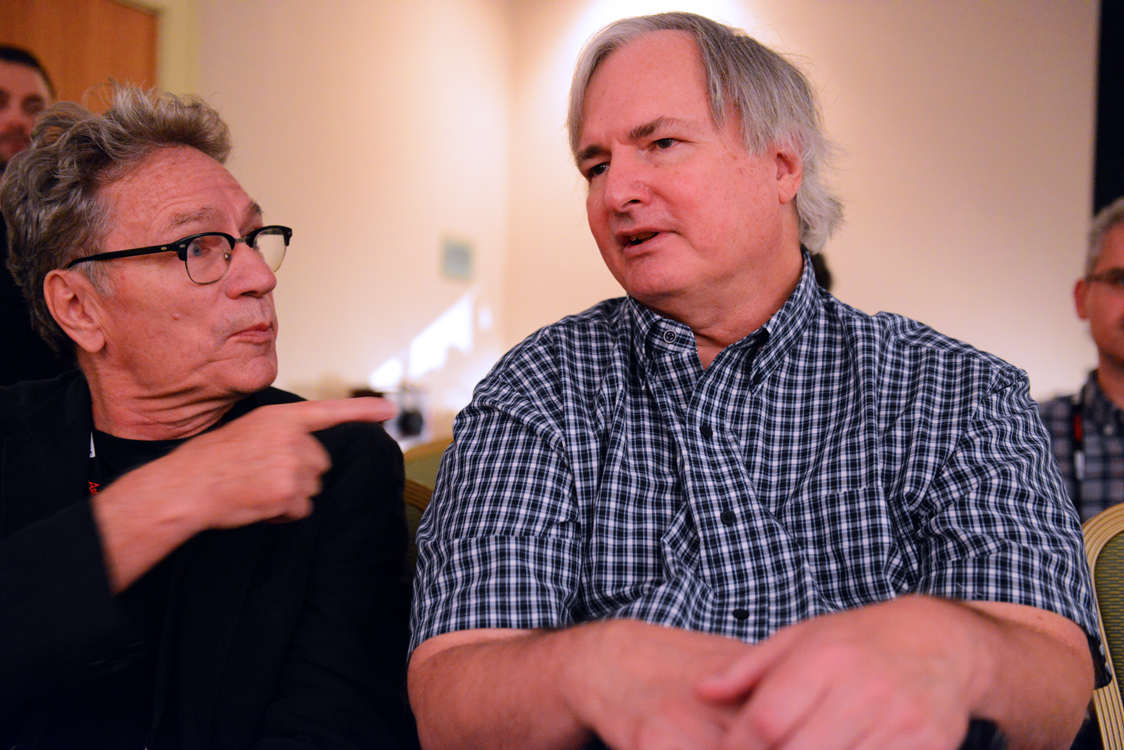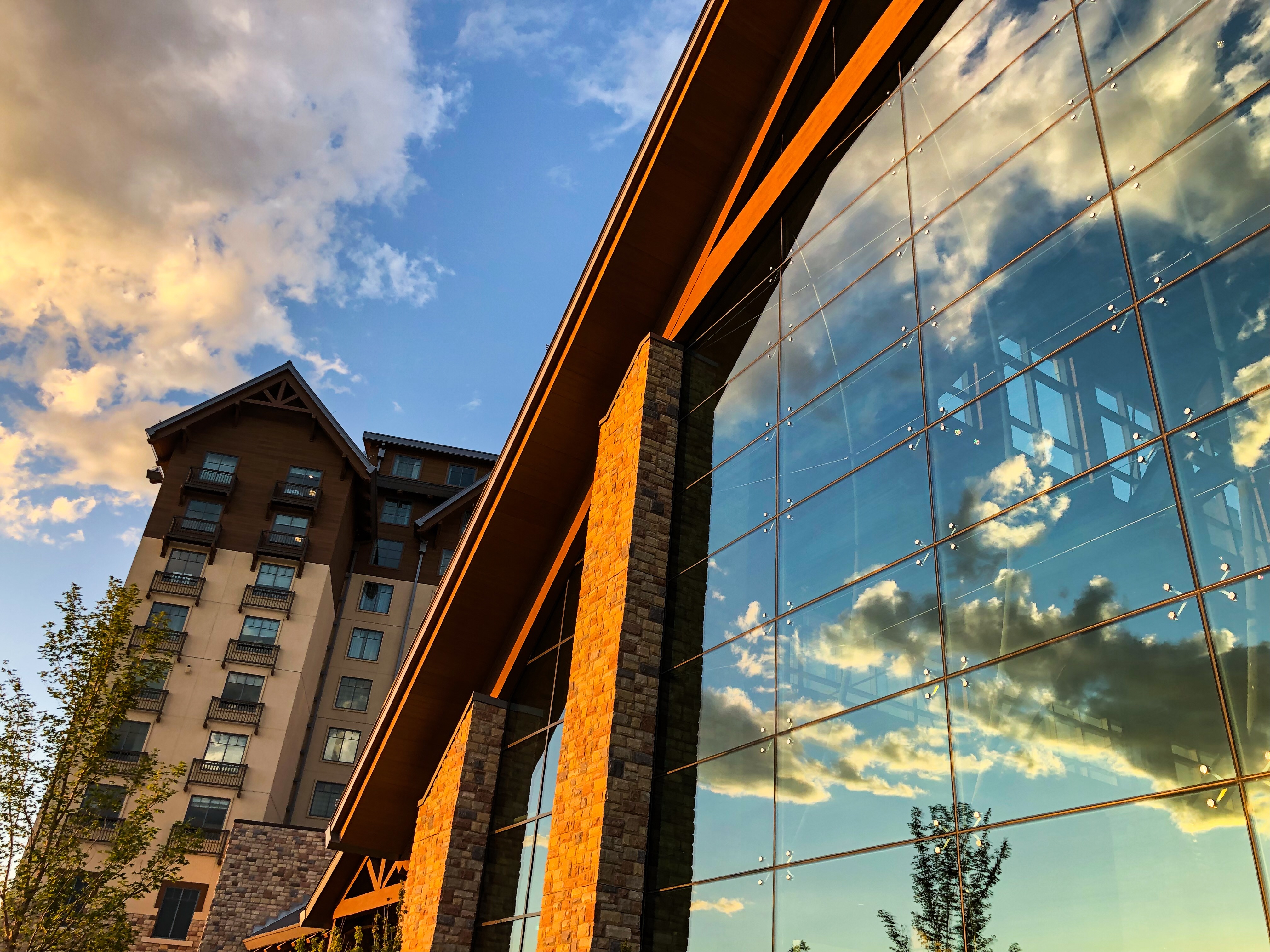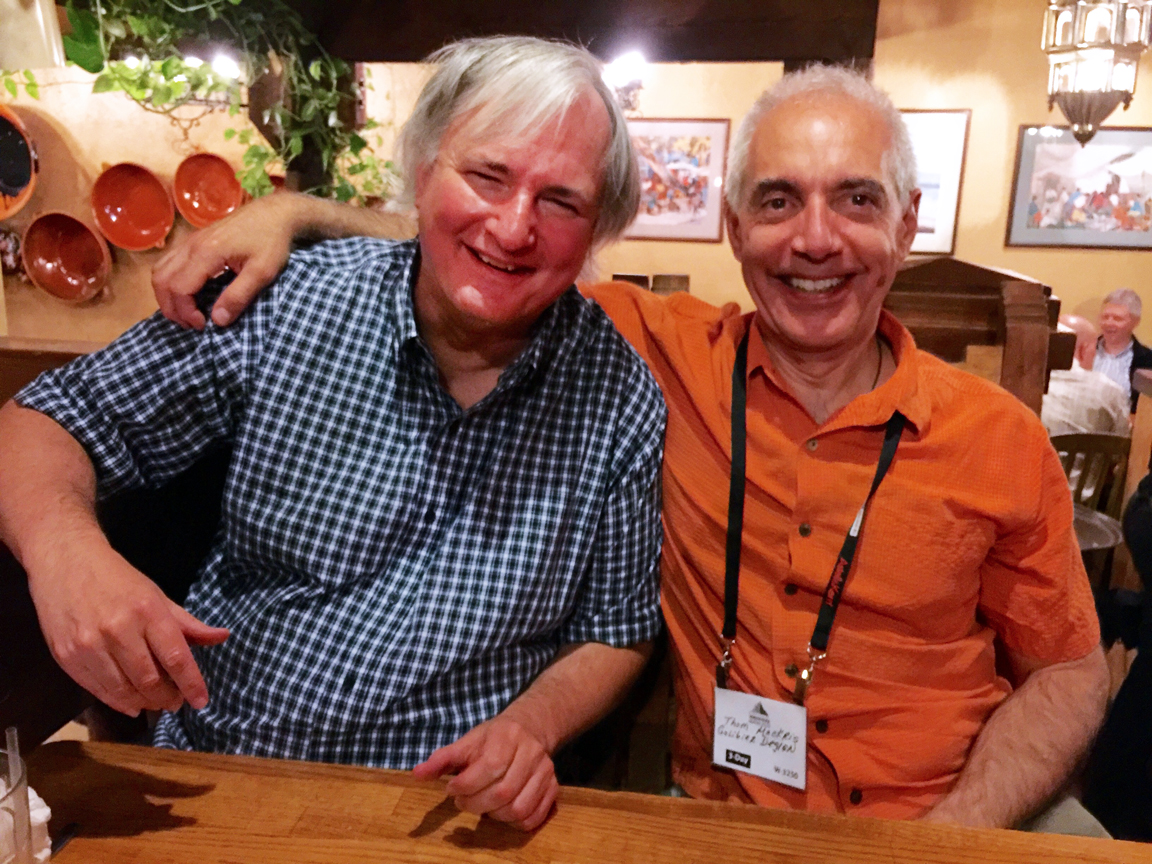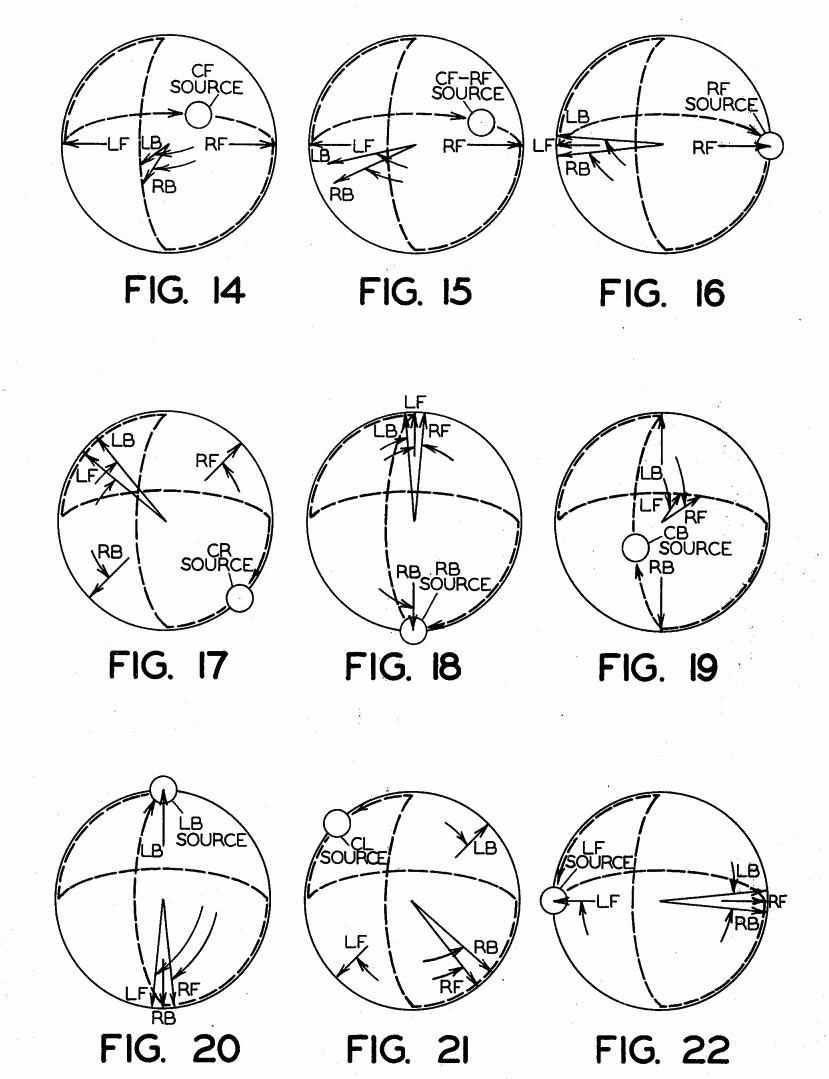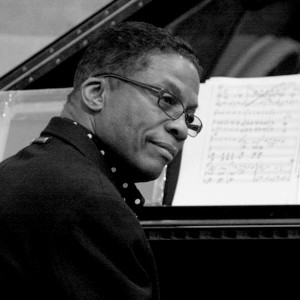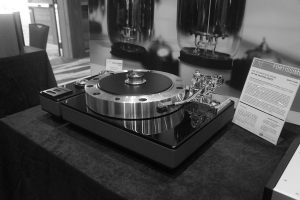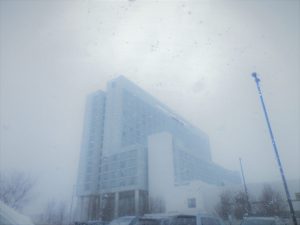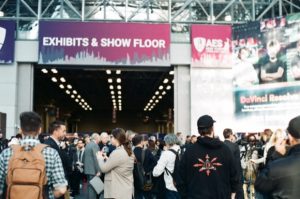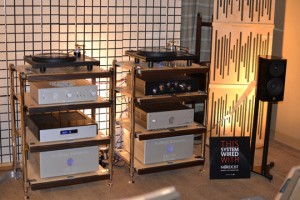Gary Dahl, Thom Mackris (of Galibier Designs) and I have been working on a high-efficiency speaker for a while now. This is the outcome of the enormous "Beyond the Ariel" thread on diyAudio. Gary was the first to arrive at the finish line, with the system that appears on the most recent pages of the thread. He's been enjoying it for several months now, and has demo-ed it for his friends in the Seattle/Puget Sound area. I take his musical impressions seriously, since he's a conductor of choir and orchestra. Rather than a music or hifi critic, he is a creator, and can hear if things are out of balance, the musical phrasing or timing is off, and when it all comes together as a harmonious whole. When he says the new speaker is the first horn speaker that really does justice to the string section in a symphony, I listen.
Thom's been doing the high-efficiency, triode-powered thing for some years now, and both Thom Mackris and Gary have owned and used a number of high-efficiency horn speakers in their main systems. Between them, they've owned Altec A7's, Altec 604 Duplex, the eXemplars, the Azzolinos, and several others, as well as a collection of more mainstream (lower efficiency) speakers.
There's a certain esthetic to artisan-made low-powered amplifiers and high-efficiency speakers. The dynamics and tone colors are very different than mainstream audio, even ultra high-end audio at stratospheric prices. Magazine critics from the mainstream press might say vacuum-tube amps and high-efficiency speakers are inherently colored, but I'd say that's true for the majority of commercial products and the less well-thought-out DIY efforts. At the highest level of practice, there are subtle qualities of beauty, delicacy, realism of musical tone, and sheer dynamic thrill-factor.
As we know, audiophiles are a tiny fraction of the MP3-loving mass market, and there are no signs of the market-share increasing. On the contrary, it's painfully obvious that our demographic is getting smaller by the year. The subset of triode enthusiasts is even smaller, and it only partially overlaps with mainstream high-end audio.
In a retail and trade-show world dominated by home theater and portable iDevices, there's not much shelf-space for high-end audio, and no space at all for esoteric tube amps. Most dealers won't carry anything with tubes, much less amplifiers with less than 20 watts and direct-heated triodes that cost more than $100 each. Most audiophiles have been indoctrinated with the equation that More Power = Mo' Bettah, and that's not going to change in an age when 500 watts of Class AB or Class D power is considered just enough.
Nearly all of the "buzz" in the triode/high-efficiency world comes from the DIY universe, since the things that are shown at regional get-togethers like the European Triode Festival (and other DIY get-togethers) are not available at hifi dealers or trade shows. The commercial sector is usually several years behind the DIY'ers, sometimes as much as ten or more years behind. I saw lots of things are the 2004 ETF that I've never seen at any trade show; too esoteric, too much labor to hand-assemble, or just too weird and bizarre for any kind of market acceptance. So it's a social thing as much as anything, but also an opportunity to hear what's possible outside the context of high-end magazines, hifi dealers, and trade shows.
There's a gap in the market for triode enthusiasts; we're not going to switch over to big, expensive black boxes filled with circuit boards and transistors. Once you get the triode "bug", you don't go back. The tonality and sheer beauty of the music is very addictive, and it's painful to give it up for the sake of having brand XYZ audiophile-approved loudspeaker. So there are three solutions for triode-fans:
First, use conventional speakers in a small listening room, and give up listening at classical or rock-concert live-performance levels. Bass quality in particular will suffer. Some are OK with this compromise, others aren't. It depends on your tastes. Regardless of taste, you will not be hearing either the amplifier or the speaker at its best, since the speaker needs more power and control, and the amplifier is right at the top of its power range.
Second, track down vintage speakers (good luck with eBay or Audiogon) and mentally adjust to vintage sound, which is very colored by modern standards. When the vintage colorations become too much to take, the DIY'er either sells the speaker or begins a series of modification and upgrade projects, trying to drag the kicking and screaming vintage speaker into the 21st century. After struggling with failed mods for several years, many enthusiasts give up and buy whatever they can find that sounds half-decent. (Despite their apparent simplicity, loudspeakers are harder to design than amplifiers, and anything involving horns is the most difficult part of all.)
Third, find (or build) a contemporary high-efficiency speaker that also meets modern standards for flat response, lack of coloration, and image quality, while retaining the high-efficiency virtues of vivid tonality and true-to-life dynamics. Professional-quality speaker drivers are quite a bit more expensive than audiophile drivers, and typically require extensive crossover equalization to straighten out the response. Speakers like this are the rarest of all, and require design skills from the vintage, professional, and modern high-end worlds. Some of products tilt vintage, some tilt prosound, and others tilt in the audiophile direction, which gives them different presentations and characters (we'll be seeing them later in the article).
Where can you hear something like this? Regional DIY shows are one place; that's where the really out-there concepts are demonstrated for the first time. Some work, some don't, but there's no commercial pressure, just the fun of trying something new. Exhibiting at the Rocky Mountain Audio Festival indicates a deeper commitment, since even small rooms start at $3,500 for the weekend, and big rooms can cost more than $5,500. And the RMAF is about as cheap as it gets; the trade-only Consumer Electronics Show in Las Vegas runs more like $15,000 to $35,000 for the weekend.
Since exhibition costs have to paid out of profits, it only makes sense for manufacturers to show what they think will sell to the audio public; a trade show is a gamble that the public will respond, and with any luck, buy what is shown. Otherwise, it's many thousands of dollars down the tube, as well as a stressful and emotionally draining experience for the exhibitors. I've been on both sides of the fence on this one, and know what it feels like to run a crowded and noisy demo room for two days straight, with little time off for R&R and seeing the rest of the show. In contrast, the DIY get-togethers are free for the exhibitors (unless they are commercial), and much lower stress for everyone. So people take a lot more chances with zany new ideas, and the atmosphere is way more relaxed.
If the high-pressure (and extremely expensive and stressful) CES is at one end of the commercial spectrum, and casual get-togethers of DIY enthusiasts are on the other, the RMAF is about in the middle. You actually get to meet the designers in person… sometimes running the room, and sometimes wandering the hallways, just like you and me. The CES is all about marketing, with the designers hidden out of sight, or not attending the show at all (hotel prices during the CES are pretty steep, since it draws more than 100,000 people). If you get CES wrong, or offend the wrong reviewer from a high-profile magazine, that can be the end of your company. A lot of small companies exhibit once at the CES and are never seen again. It's a make-or-break show, and you can feel it in the demo rooms and hallways.
The RMAF doesn't price the little guys out of existence, and is more laid-back experience for everyone. True, Denver isn't close to anywhere, but it's a popular stopover for musicians playing at Red Rocks and many assorted music festivals in the ski towns in the mountains, and we have a good collection of high-end manufacturers in the group of cities that run up and down I-25 on the east face of the Rockies. And the Colorado Audio Society has done a crackerjack job of running the friendly RMAF at the Sheraton for more than ten years. Although yours truly is a lazy-ass member of the CAS and has never once volunteered for the show, I have to give a big shout-out to the tireless volunteers who run a commercial-quality show … for free, just for the love of sound. These things take a huge amount of work, planning, and on-the-fly problem solving.
Gary's been wanting to return to the RMAF for three years, and Thom and I are only 40 miles north of the show, so it's an easy drive for us. Gary has several months of actually listening to the new speaker, while Thom and I are completing design work on our versions of it. A perfect opportunity for the experienced horn guys to listen what's at the RMAF show, and see what's out there now.
I got my usual "Press" badge and decided this year to do the honest thing and actually write about the experience, and submit another rambling article to my long-suffering editor, David Robinson. Sorry, David, this isn't really anything like a proper show report. This article is aimed at the triode nuts and horn enthusiasts. We didn't even go into rooms with compact speakers with 6" midranges and ribbon tweeters, and boy were there a lot of them. Lots and lots and lots. One glance and we'd keep walking down the hallways. We avoided most of the transistor-powered rooms, too, and that took care of 80% percent of the show right there. Since there were more than 170 exhibitors, maybe just as well.
As in previous years, there was a plague of those #&*$@# music servers. Ugh. Most of the demo guys have play the same dull stuff over and over again on a short loop, and there's no chance of playing your own music. Then again, the music I bring gets me thrown out of rooms. I asked one exhibitor to play the opening track of Koyaanisqatsi (it sounded great, by the way), and I also like Ulrich Schnauss, German techno and London shoegazer music. Thom Mackris likes Laurie Anderson (on LP only please!), and Gary asks for orchestral music, which throws most of the demo guys for a loop. Diana Krall, you betcha, they all got that. Or audiophile blues, from performers you never heard of. Music servers, no thank you, unless it's all high-res content (which it usually isn't). A big YES to phonographs and pro-quality tape decks. The front end matters, guys, and so does taste. From Gary Dahl's perspective, if the hifi company doesn't have the wit to offer listenable music, that reflects on their musical priorities.
There were only about five or so exhibitors who were showing high-efficiency speakers with appropriate vacuum-tube amplifiers (no 500-watt Class D amplifiers, please). So that made it easier. Two exhibitors with well-known names (which I heard at past RMAF shows) were unfortunately not as good this year; one was just OK, and the other was harsh, shrill, with zero bass (this was a speaker listed at more than $50,000/pair). Why had things changed so much in the course of a year? This was well beyond room acoustics or poor choice of amplifiers; the response as grossly nonflat, with no bass at all, and brutally harsh in the mids and highs. I've heard better PA's in a railway station. The demo mystified me; it was from a world-famous manufacturer with a high profile in the industry, and a staff of talented engineers. Both speakers broken somehow? Maybe. It happens. But possibly the result of ill-advised marketing pressures on the engineering staff.
Well, that's hifi shows for you. Always full of surprises. You can't go by the pretty pictures, or the reviews in the glossy magazines and flashy websites. You have to listen for yourself.
The two stars of the show (in the high-efficiency class) were the Volti Vittora and the Zephrin 46 from Audio Kinesis. The Volti has a big, bouncy sound that is the essence what the high-efficiency sound is all about. Snap and authority galore, at any level you could want, with an overall warm balance and vivid, colorful tonality. One of the visitors produced a Jackson Browne & David Lindley live concert CD that was just stunning; the feel of "being right there" was powerful, along with the overall sound of the Vitarra. It sounded much better than last year; crossover changes, a different room, I have no idea what's different this time around. But the Vittora sounded engaging, lively, and a lot of fun. Wondering what high efficiency and triodes are all about? Listen to the Vittora.
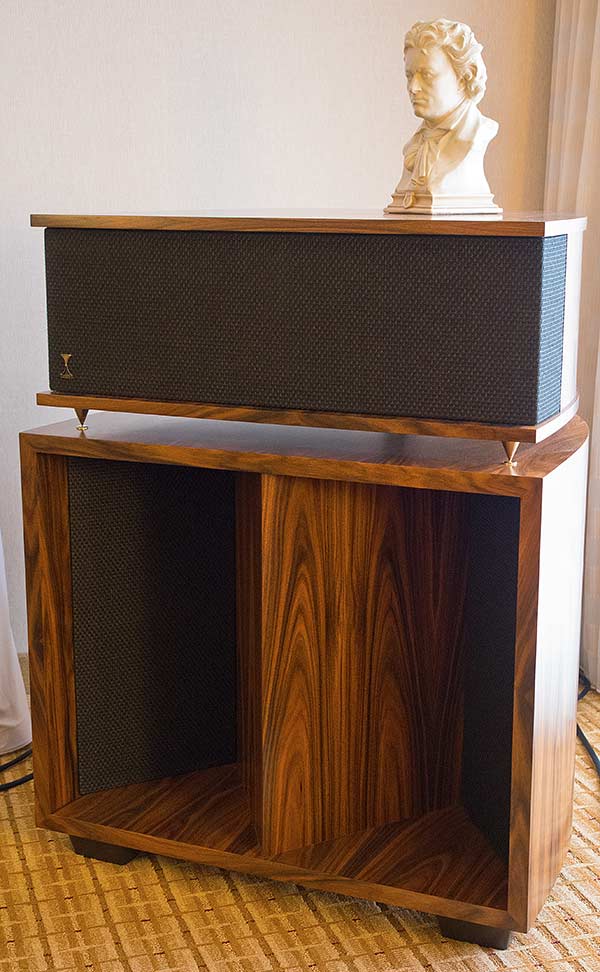
The Audio Kinesis room was right next door, and Duke Lejune was demoing the Zephrin 46, an innovative high-efficiency speaker with excellent spatial qualities (which can be a weak point of horn speakers). Duke demonstrated the effect of up-firing spatial radiators with an A/B switch, which changed the spatial impression from the usual up-front horn sound to a more realistic and open-sounding presentation like an electrostatic array… but with a lot more authority and presence. Despite the compact size, there was nothing compact about the presentation; it was Duke that tolerated my choice of the opening section of Koyaanisqatsi, and the pipe organ under the male choir was at real-life levels and realism. Most of the little speakers at the show would have flunked this track pretty badly. The tone quality was well-rounded and colorful; Duke knows his crossovers, and the speaker was even-handed, not favoring one kind of music over another, and presenting each at their best. I didn't hear them caught-out on anything, and the sound was always vivid, colorful, and dynamic, no matter what was playing. They may look unusual, but they sound great. (Sorry about the funky photograph; it was taken under dim room lighting, and doesn't correctly render the wood tone.)
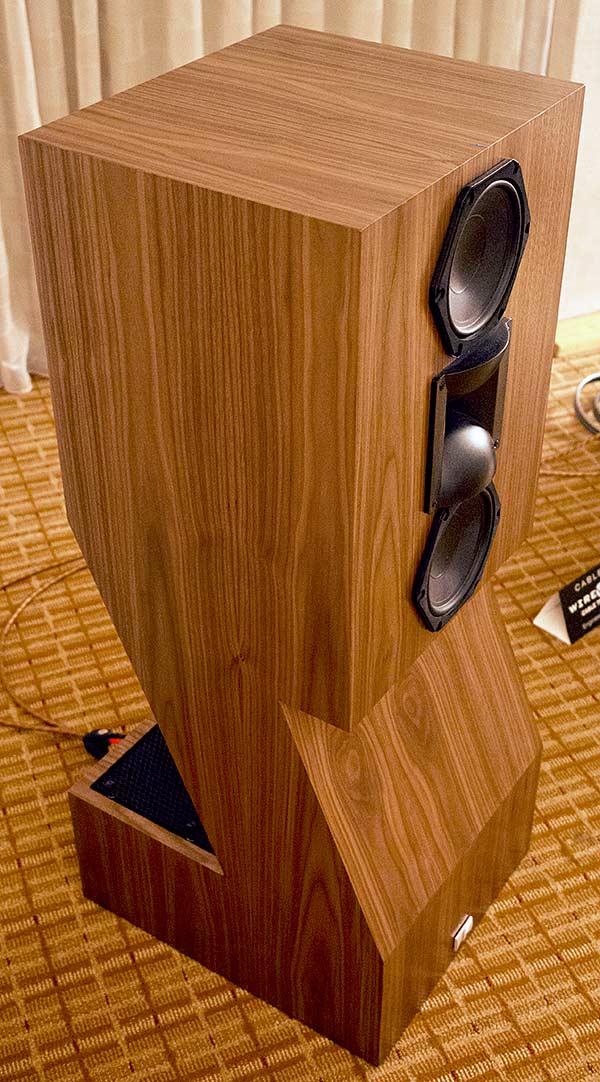
And a surprise. My favorite room at the show, exaSound, did not have high-efficiency speakers, tube amps, a phonograph, or even a linestage. I'll come right out and say it; this was the best digital sound I've ever heard, and at times a dead ringer for first (not second) generation analog mastertape. The system couldn't have been much simpler: an exaSound 28 eight-channel DAC, connected directly to a five-channel Bryston 9BSST amplifier, driving five Magnepan 1.7 loudspeakers. The room was small, almost closet-sized, with room for only six chairs… three in front, three directly behind them. The rest was speakers, which were no more than five feet away from where I sat (in the center, of course).
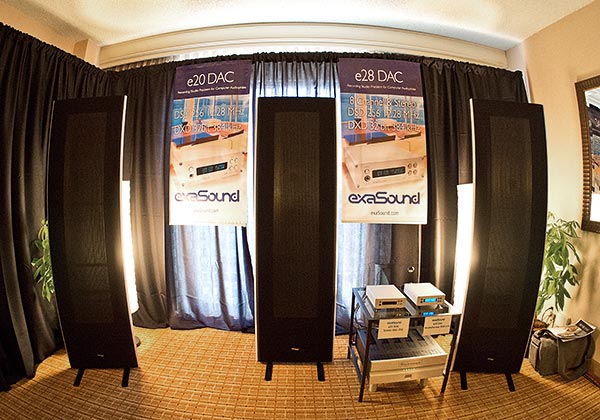
I came back to this room, on Friday, Saturday, and Sunday, and the sound was wonderful each time. This is rare, almost unheard-of, at hifi shows. It was always effortlessly mastertape realistic, with no digital artifacts at all. The source material was superlative, ranging from 1x, 2x, and 4x DSD, five-channel surround DSD, and 1x and 2x DXD (a professional 352.8/32 format used for editing DSD masters without generation loss).

The real stunners were five-channel DSD, which sounded as good as what I've heard at the local Sonoma mastering lab in Boulder, and two-channel DXD. Wow. I don't usually hear sound like this. Even our hard-core all-analog guy, Thom Mackris the turntable builder, had to admit that it actually sounded pretty good. I'm not a fan of transistor amps or Magnepans, but there was nothing to criticize in this room. The sound was always superb, no matter what. Even plain old 44.1/16 content, the bottom of the digital barrel, sounded free of grit and grain, just lower resolution.
It is not true that 44.1/16 (Red Book CD standard) has to sound gritty and "digital". No. That's bad conversion, which is very, very common and hard to avoid. If the conversion quality is high enough, it just sounds lower-resolution than the professional formats. It's also bad conversion when DSD sounds radically different than 88.2/24 or higher quality PCM. Both formats, not just one, should approach analog mastertape quality, If a converter favors one over the other, something's wrong, and nearly all converters I've heard to date seem to have a preference.
The exaSound converter has no preference; at the level of 176.4/24 PCM, or 2x DSD, everything sounded like a mastertape. At the highest level (which for me is DXD), the "recorded" sound disappeared completely, and it sounded like a direct mike-feed. That's how good DXD is. It's refreshing to know that at the professional level, and now through downloads, we can hear sound like this. The engineer who made these recordings was there on Saturday, and I congratulated him on the remarkable sound quality of the recordings.
What surprised me was everything was against the exaSound demo; a small room with only a little damping on the walls (see pic), a minimalist system with transistor amplification, and speakers that are not known for their dynamics. Wrong. The sound was 3-dimensional (in all directions) and far larger than the room, natural-sounding, and powerfully dynamic. Maybe exaSound was just lucky, and got a "magic room", but I don't believe you get lucky three days in a row, and playing all kinds of music (including full-scale classical and organ music). No. That doesn't happen by accident. Everyone else was struggling with the funky room acoustics, but this sounded like a professional DSD/DXD mastering studio. I honestly don't know how they did it.
What did our little band of three learn from our travels to the glass canyons of the Denver Tech Center? You must go and hear for yourself! No disrespect to the review staff at PFO, but you have to hear for yourself. The equipment that was most talked-about in the magazines and newsgroups was often dismal, sometimes shockingly so, while brands that were not as well-known surprised me (and the others) with their beauty and quality. I was about to generalize that "tubes are the way"… and in most rooms they were a mark of quality… but the exaSound room showed me that an unusual amplifier and speaker setup was the biggest surprise of the show.
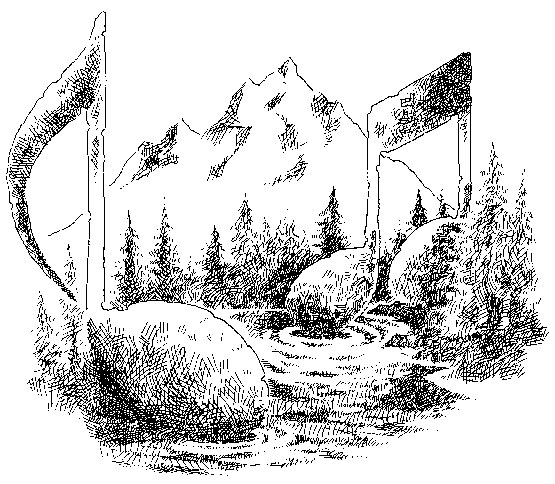
[Photographs by Olson; cartoon by Bruce Walker]




